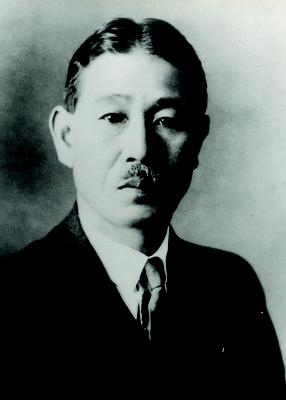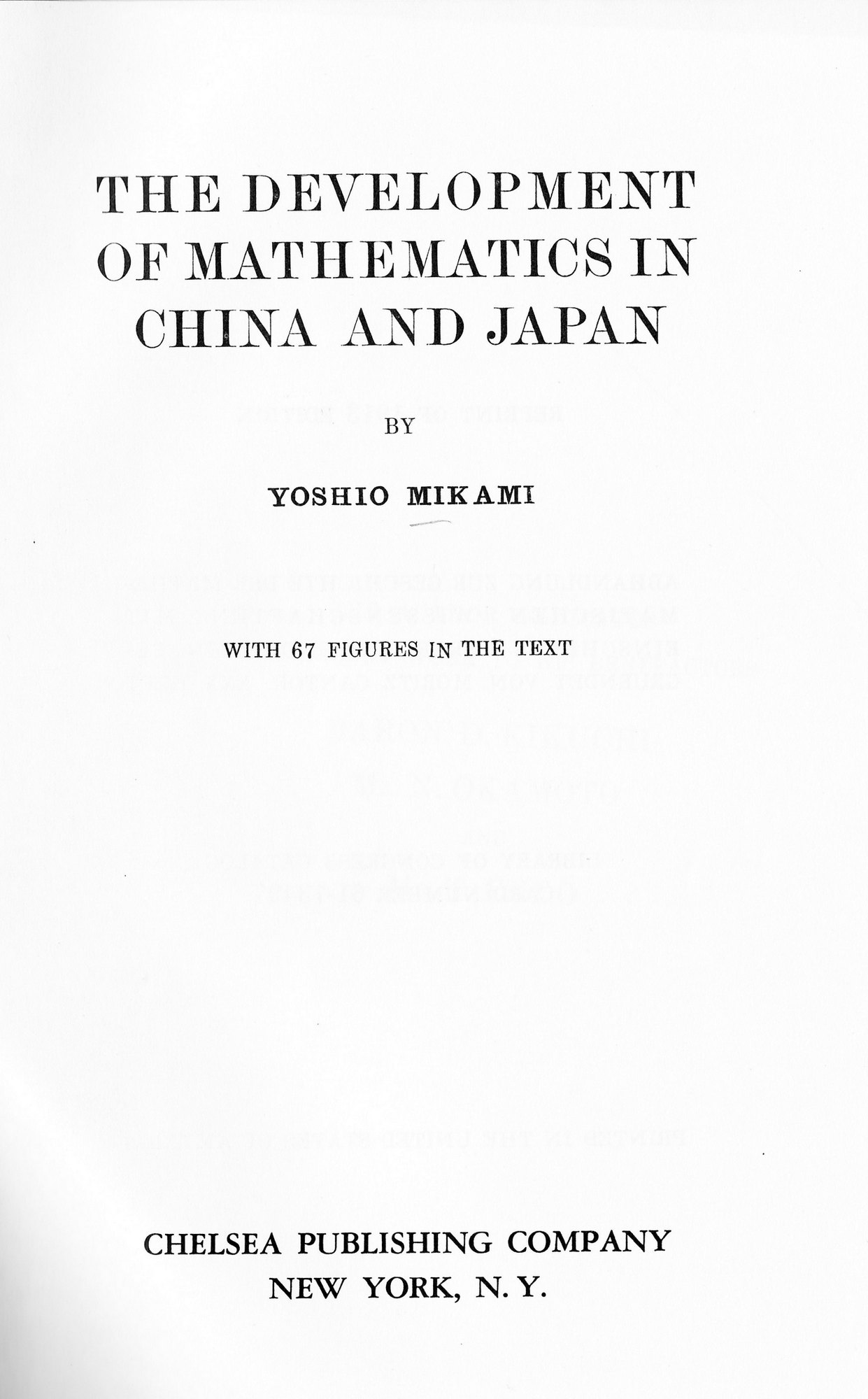|
Matsusaburo Fujiwara
Matsusaburo Fujiwara (, ''Fujiwara Matsusaburō'', 14 February 1881, Tsu, Mie – 12 October 1946, Fukushima) was a Japanese mathematician and historian of mathematics. Education and career Fujiwara graduated in June 1902 from secondary school at the Third Higher School in Kyoto and then studied mathematics at the University of Tokyo, where he graduated in 1905. His most important teacher was Rikitaro Fujisawa (1861–1933). In 1906 he became a secondary school teacher at the First Higher School ''Daiichi Kōtō Gakkō'' in Tokyo. In 1908 Fujiwara and Tsuruichi Hayashi (1873–1935) were appointed professors at Tohoku University in Sendai. To prepare for his professorial duties, Fujiwara was sent to study from 1908 to 1911 in Göttingen, Paris and Berlin.In Göttingen, Fujiwara probably studied with David Hilbert — on the occasion of Hilbert's 60th birthday in 1922 Fujiwara published his congratulations and is included in the photo album for the occasion. After his return in F ... [...More Info...] [...Related Items...] OR: [Wikipedia] [Google] [Baidu] |
Yoshio Mikami
was a Japanese mathematician and historian of '' Japanese mathematics''. He was born February 16, 1875, in Kotachi, Hiroshima prefecture. He attended the High School of Tohoku University, and in 1911 was admitted to the Imperial University of Tokyo. He studied history of Japanese and Chinese mathematics. In 1913, he published "The Development of Mathematics in China and Japan" in Leipzig.Yoshio Mikami, The Development of Mathematics in China and Japan, 1913, Library of Congress 61-13497 This book consisted of two parts with 47 chapters. Part one has 21 chapters that describe in depth several important Chinese mathematicians and mathematical classics including Liu Hui, Shen Kuo, Qin Jiushao, Sun Tzu, The Nine Chapters on the Mathematical Art, Mathematical Treatise in Nine Sections, Li Ye, Zhu Shijie and study on π. Part II deals with important ''wasan'' mathematicians and their works, including Kambei Mori, Yoshida Koyu, Kowa Seki, Imamura Chisho, Takahara Kisshu, Kurushima ... [...More Info...] [...Related Items...] OR: [Wikipedia] [Google] [Baidu] |
19th-century Japanese Mathematicians
The 19th (nineteenth) century began on 1 January 1801 ( MDCCCI), and ended on 31 December 1900 ( MCM). The 19th century was the ninth century of the 2nd millennium. The 19th century was characterized by vast social upheaval. Slavery was abolished in much of Europe and the Americas. The First Industrial Revolution, though it began in the late 18th century, expanding beyond its British homeland for the first time during this century, particularly remaking the economies and societies of the Low Countries, the Rhineland, Northern Italy, and the Northeastern United States. A few decades later, the Second Industrial Revolution led to ever more massive urbanization and much higher levels of productivity, profit, and prosperity, a pattern that continued into the 20th century. The Islamic gunpowder empires fell into decline and European imperialism brought much of South Asia, Southeast Asia, and almost all of Africa under colonial rule. It was also marked by the collapse of the large ... [...More Info...] [...Related Items...] OR: [Wikipedia] [Google] [Baidu] |
1946 Deaths
Events January * January 6 - The first general election ever in Vietnam is held. * January 7 – The Allies recognize the Austrian republic with its 1937 borders, and divide the country into four occupation zones. * January 10 ** The first meeting of the United Nations is held, at Methodist Central Hall Westminster in London. ** ''Project Diana'' bounces radar waves off the Moon, measuring the exact distance between the Earth and the Moon, and proves that communication is possible between Earth and outer space, effectively opening the Space Age. * January 11 - Enver Hoxha declares the People's Republic of Albania, with himself as prime minister. * January 16 – Charles de Gaulle resigns as head of the French provisional government. * January 17 - The United Nations Security Council holds its first session, at Church House, Westminster in London. * January 19 ** The Bell XS-1 is test flown for the first time (unpowered), with Bell's chief test pilot Jack W ... [...More Info...] [...Related Items...] OR: [Wikipedia] [Google] [Baidu] |
1881 Births
Events January–March * January 1– 24 – Siege of Geok Tepe: Russian troops under General Mikhail Skobelev defeat the Turkomans. * January 13 – War of the Pacific – Battle of San Juan and Chorrillos: The Chilean army defeats Peruvian forces. * January 15 – War of the Pacific – Battle of Miraflores: The Chileans take Lima, capital of Peru, after defeating its second line of defense in Miraflores. * January 24 – William Edward Forster, chief secretary for Ireland, introduces his Coercion Bill, which temporarily suspends habeas corpus so that those people suspected of committing an offence can be detained without trial; it goes through a long debate before it is accepted February 2. * January 25 – Thomas Edison and Alexander Graham Bell form the Oriental Telephone Company. * February 13 – The first issue of the feminist newspaper ''La Citoyenne'' is published by Hubertine Auclert. * February 16 – ... [...More Info...] [...Related Items...] OR: [Wikipedia] [Google] [Baidu] |
Sōichi Kakeya
was a Japanese mathematician who worked mainly in mathematical analysis and who posed the Kakeya problem and solved a version of the transportation problem. He received the Imperial Prize of the Japan Academy in 1928, and was elected to the Japan Academy The Japan Academy ( Japanese: 日本学士院, ''Nihon Gakushiin'') is an honorary organisation and science academy founded in 1879 to bring together leading Japanese scholars with distinguished records of scientific achievements. The Academy is ... in 1934. References * Kakeya, S. (1912-13) "On the Limits of the Roots of an Algebraic Equation with Positive Coefficients," Tohoku Mathematical Journal (First Series),2:140–142. 1886 births 1947 deaths 20th-century Japanese mathematicians University of Tokyo alumni Academic staff of the University of Tokyo Academic staff of the University of Tsukuba Laureates of the Imperial Prize {{Asia-mathematician-stub ... [...More Info...] [...Related Items...] OR: [Wikipedia] [Google] [Baidu] |
Fujiwara Wurzeln 1926
Fujiwara (, written: 藤原 lit. "''Wisteria'' field") is a Japanese surname. (In English conversation it is likely to be rendered as .) Notable people with the surname include: ; Families * The Fujiwara clan and its members ** Fujiwara no Kamatari ** Fujiwara no Fuhito ** Fujiwara no Michinaga * Northern Fujiwara clan ** Fujiwara no Kiyohira ; Art and entertainment * Fujiwara (owarai), Japanese comedy duo (kombi) consisting of Toshifumi Fujimoto (藤本敏史) and Takayuki Haranishi (原西孝幸) * Atsushi Fujiwara (born 1963), Japanese photographer * Harry Fujiwara (Mr. Fuji) (1934 - 2016), Japanese-American wrestler * Hiroshi Fujiwara (born 1964), Japanese musician, trendsetter, producer, and designer * Kamatari Fujiwara (1905 - 1985), Japanese actor * Kei Fujiwara (born 1957), Japanese actress and film director * Keiji Fujiwara (1964 - 2020), Japanese voice actor * Motoo Fujiwara, lead singer and composer for the Japanese rock band Bump of Chicken * Tokuro Fujiwara, Jap ... [...More Info...] [...Related Items...] OR: [Wikipedia] [Google] [Baidu] |
International Congress Of Mathematicians
The International Congress of Mathematicians (ICM) is the largest conference for the topic of mathematics. It meets once every four years, hosted by the International Mathematical Union (IMU). The Fields Medals, the Nevanlinna Prize (to be renamed as the IMU Abacus Medal), the Gauss Prize, and the Chern Medal are awarded during the congress's opening ceremony. Each congress is memorialized by a printed set of Proceedings recording academic papers based on invited talks intended to be relevant to current topics of general interest. Being invited to talk at the ICM has been called "the equivalent ... of an induction to a hall of fame". History Felix Klein and Georg Cantor are credited with putting forward the idea of an international congress of mathematicians in the 1890s.A. John Coleman"Mathematics without borders": a book review ''CMS Notes'', vol 31, no. 3, April 1999, pp. 3-5 The University of Chicago, which had opened in 1892, organized an International Mathema ... [...More Info...] [...Related Items...] OR: [Wikipedia] [Google] [Baidu] |
Japan Academy
The Japan Academy ( Japanese: 日本学士院, ''Nihon Gakushiin'') is an honorary organisation and science academy founded in 1879 to bring together leading Japanese scholars with distinguished records of scientific achievements. The Academy is currently an extraordinary organ of the Ministry of Education, Culture, Sports, Science and Technology with its headquarters located in Taito, Tokyo, Japan. Election to the Academy is considered the highest distinction a scholar can achieve, and members enjoy life tenure and an annual monetary stipend. History In 1973, Meiroku-sha (Meairoku Society) was founded. The main people of Meiroku-sha involved in Meiroku-sha were from Kaiseijo (later transformed into University of Tokyo and so on) and Keio Gijuku (Keio University). In an effort to replicate the institutional landscape found in many Western nations, the leaders of the Meiji government sought to create a national academy of scholars and scientists modelled to the British Royal ... [...More Info...] [...Related Items...] OR: [Wikipedia] [Google] [Baidu] |
Teiji Takagi
Teiji Takagi (高木 貞治 ''Takagi Teiji'', April 21, 1875 – February 28, 1960) was a Japanese mathematician, best known for proving the Takagi existence theorem in class field theory. The Blancmange curve, the graph of a nowhere-differentiable but uniformly continuous function, is also called the Takagi curve after his work on it. Biography He was born in the rural area of the Gifu Prefecture, Japan. He began learning mathematics in middle school, reading texts in English since none were available in Japanese. After attending a high school for gifted students, he went on to the Imperial University (later Tokyo Imperial University), at that time the only university in Japan before the Imperial University System was established on June 18, 1897. There he learned mathematics from such European classic texts as Salmon's ''Algebra'' and Weber's ''Lehrbuch der Algebra''. Aided by Hilbert, he then studied at Göttingen. Aside from his work in algebraic number theory he wrote a g ... [...More Info...] [...Related Items...] OR: [Wikipedia] [Google] [Baidu] |
Japanese Mathematics
denotes a distinct kind of mathematics which was developed in Japan during the Edo period (1603–1867). The term ''wasan'', from ''wa'' ("Japanese") and ''san'' ("calculation"), was coined in the 1870s and employed to distinguish native Japanese mathematical theory from Western mathematics (洋算 ''yōsan''). In the history of mathematics, the development of ''wasan'' falls outside the Western realm. At the beginning of the Meiji period (1868–1912), Japan and its people opened themselves to the West. Japanese scholars adopted Western mathematical technique, and this led to a decline of interest in the ideas used in ''wasan''. History The Japanese mathematical schema evolved during a period when Japan's people were isolated from European influences, but instead borrowed from ancient mathematical texts written in China, including those from the Yuan dynasty and earlier. The Japanese mathematicians Yoshida Shichibei Kōyū, Imamura Chishō, and Takahara Kisshu are among the ... [...More Info...] [...Related Items...] OR: [Wikipedia] [Google] [Baidu] |




